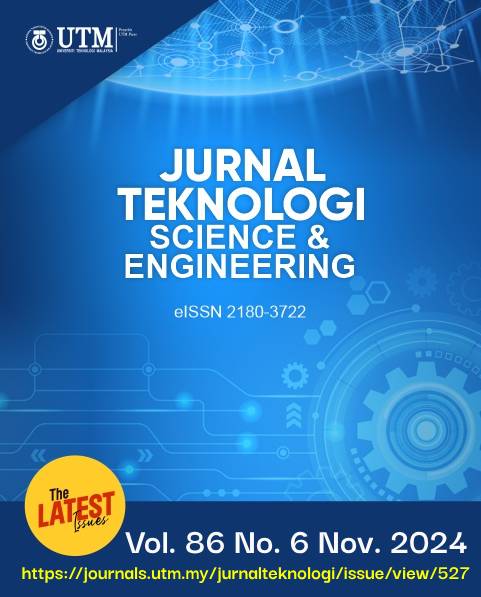CRACKING PATTERN ANALYSIS OF THE TURNING BAND METHOD (TBM) APPLICATION ON A SINGLE-REINFORCEMENT BAR CONCRETE BEAM MODELLING USING THE MAZARS DAMAGE
DOI:
https://doi.org/10.11113/jurnalteknologi.v86.21817Keywords:
Heterogeneity, Random Field, Turning Band Method, Mazar Damage Model, Crack PatternAbstract
The development of crack patterns in reinforced concrete structures is a randomly stochastic process influenced by the heterogeneous nature of concrete materials, which impacts the sensitivity to damage and variability in mechanical properties. The numerical simulation of damage pattern appearance on the reinforced concrete for special building structures needs a realistic result, especially in terms of crack distribution. The Turning Band Method (TBM) serves as a tool for assessing the variability of concrete heterogeneity, functioning as an operator to generate a random variable for each specific field. In this study, the investigation of crack patterns in reinforced concrete structures involves using a simple concrete beam sample, measuring 10x10x50 cm3, with a single longitudinal reinforcement cast in the centre. This beam is subjected to an axial tensile loading, while the Mazar Damage Model is employed as the concrete behaviour law. Through the implementation of The Turning Band Method (TBM) and the variation of the random field parameters, distinct crack patterns are observed, not only the number but also the locations of cracks. The use of a smaller correlation length showed 2 cracks while the larger size had around 1 to 3 cracks, with the first crack localizations of each sample generally occurring in the middle surface, in which a noticeable contrast to non-TBM modelling just displays 1 crack. Furthermore, the resulting probability of cracks for ten random draws demonstrates similarity to experimental tests and numerical simulation of the previous study, both at global and local levels.
References
Francis Barre, Philippe Bisch, Danièle Chauvel, Jacques Cortade, Jean-François Coste, Jean-Philippe Dubois, Silvano Erlicher, Etienne Gallitre, Pierre Labbé, Jacky Mazars, Claude Rospars, Alain Sellier, Jean-Michel Torrenti, François Toutlemonde. 2016. Control of Cracking in Reinforced Concrete Structures Research Project CEOS.fr. John Wiley & Sons, Inc.
S. Shahidan, S. R. Abdullah, and I. Ismail. 2015. Relationship Between AE Signal Strength and Absolute Energy in Determining Damage Classification of Concrete Structures. J. Teknol. 78(5): 1-8.
Doi: https://doi.org/10.11113/jt.v78.8248.
N. H. Suliman, A. A. Bakar, S. H. Hamzah, and N. A. Ahmad. 2015. Crack Behaviour of Pre-Tensioned (PRT) Concrete Beam after Retrofitted with CFRP Sheets. J. Teknol. 76(9): 1-4.
Doi: https://doi.org/10.11113/jt.v76.5686.
Q. M. Shakir and B. B. Abd. 2020. Retrofitting of Self-compacting RC Half Joints with Internal Deficiencies by CFRP Fabrics. J. Teknol. 82(6): 49-62.
Doi: https://doi.org/10.11113/jurnalteknologi.v82.14416.
Maria Ghannoum. 2018. Effects of Heterogeneity of Concrete on the Mechanical Behavior of Structures at Different Scales. Materials. Université Grenoble Alpes. English. NNT: 2017GREAI035. https://tel.archives-ouvertes.fr/tel-01721630.
Z. Li. 2011. Advanced Concrete Technology. New Jersey: John Wiley & Sons, Inc.
Badan Standarisasi Nasional Indonesia. 2013. SNI 2847:2013, Persyaratan Beton Struktural untuk Bangunan Gedung. Bandung Badan Stand. Indonesia. 1-265.
X. Du and L. Jin. 2021. Size Effect in Concrete Materials and Structures.
Doi: https://doi.org/10.1007/978-981-33-4943-8.
R. Madandoust, M. Kazemi, and S. Y. Moghadam. 2017. Study on Tensile Strength of Concrete. Rom. J. Mater. January: 294-297.
Y. Goto and K. Otsuka. 1980. Experimental Studies on Cracks Formed in Concrete around Deformed Tension Bars. Proc. Japan Soc. Civ. Eng. 294: 85-100.
Doi: https://doi.org/10.2208/jscej1969.1980.294_85.
A. Michou, A. Hilaire, F. Benboudjema, G. Nahas, P. Wyniecki, and Y. Berthaud. 2015. Reinforcement-concrete Bond Behaviour: Experimentation in Drying Conditions and Meso-scale Modeling. Eng. Struct. 101: 570-582.
DOI: https://doi.org/10.1016/j.engstruct.2015.07.028
H. Q. Wu. 2010. Tension Stiffening in Reinforced Concrete - Instantaneous and Time-Dependent Behaviour. 348. unsworks.unsw.edu.au/fapi/datastream/unsworks:8336/SOURCE02%5Cn.
N. Handika, G. Casaux-Ginestet, and A. Sellier. 2015. Influence of Interface Zone Behaviour in Reinforced Concrete under Tension Loading: An Analysis based on Modelling and Digital Image Correlation. Proc. 8th Int. Conf. Comput. Plast. - Fundam. Appl. COMPLAS 2015. 122-133.
R. Van der Have, 2015. Random Fields for Non-Linear Finite Element Analysis of Reinforced Concrete. November: 244. http://repository.tudelft.nl/islandora/object/uuid:25780e9a-49c4-4085-9a65-af73119d97a7?collection=education.
A. van den Bos and A. Garofano. 2017. Crack Predictions using Random Field. Crack width Calc. Methods Large Concr. Struct. Work. Proc. from a Nord. Miniseminar. 12(November 2016): 87-94.
C. Mang. 2016. Modeling of Steel-Concrete Bonds in the Calculation of Reinforced Concrete Structures. Nuclear Energy Department, Nuclear Activities Department of Saclay, CEA Saclay.
N. Handika. 2017. Multi-cracking of Reinforced Concrete Structures: Image Correlation Analysis and Modelling. Civil Engineering. INSA de Toulouse.
S. Murakami. 1967. Continuum Damage Mechanics. 185(1): 69. Morikita Publishing Co. Ltd., Tokyo.
G. Pijaudier-cabot, J. Mazars, G. Pijaudier-cabot, J. Mazars, D. Models, and J. Lemaitre. 2017. Damage Models for Concrete. 500-512. Doi: https://doi.org/10.1016/B978-012443341-0/50056-9.
K. Hongsen, M. Melhan, N. Handika, and B. O. B. Sentosa. 2021. Parameterization of Oil Palm Shell Concrete on Numerical Damage Model Based on Laboratory Experiment using Digital Image Correlation. J. Phys. Conf. Ser. 1858(1): 202.
Doi: https://doi.org/10.1088/1742-6596/1858/1/012029.
G. Matheron. 1973. Intrinsic Random Functions and Their Applications. Adv. Appl. Probab. 5(3): 439-468.
Doi: https://doi.org/10.1017/S0001867800039379.
G. A. Fenton. 1994. Error Evaluation of Three Random‐Field Generators. J. Eng. Mech. 120(12): 2478-2497.
Doi: https://doi.org/10.1061/(ASCE)0733-9399(1994)120:12(2478)
Y. Liu, J. Li, S. Sun, and B. Yu. 2019. Advances in Gaussian Random Field Generation: A Review. Comput. Geosci. 23(5): 1011-1047.
Doi: https://doi.org/10.1007/s10596-019-09867-y.
Cast3M. http://www-cast3m.cea.fr/. Accessed Apr. 29, 2023.
M. Lloret-Cabot, G. A. Fenton, and M. A. Hicks. 2014. On the Estimation of Scale of Fluctuation in Geostatistics. Georisk Assess. Manag. Risk Eng. Syst. Geohazards. 8(2): 129-140.
Doi: https://doi.org/10.1080/17499518.2013.871189.
Code-Aster v14 0.1 documentation. 15. R7 : Material models. 15.1. [R7.01.08]: MAZARS Damage Model for Concrete. https://biba1632.gitlab.io/code-aster-manuals/docs/reference/r7.01.08.html. Accessed Dec. 10th, 2023.
E. Le Fichoux. 2011. Annotated Testing Files. 420.
Downloads
Published
Issue
Section
License
Copyright of articles that appear in Jurnal Teknologi belongs exclusively to Penerbit Universiti Teknologi Malaysia (Penerbit UTM Press). This copyright covers the rights to reproduce the article, including reprints, electronic reproductions, or any other reproductions of similar nature.
















